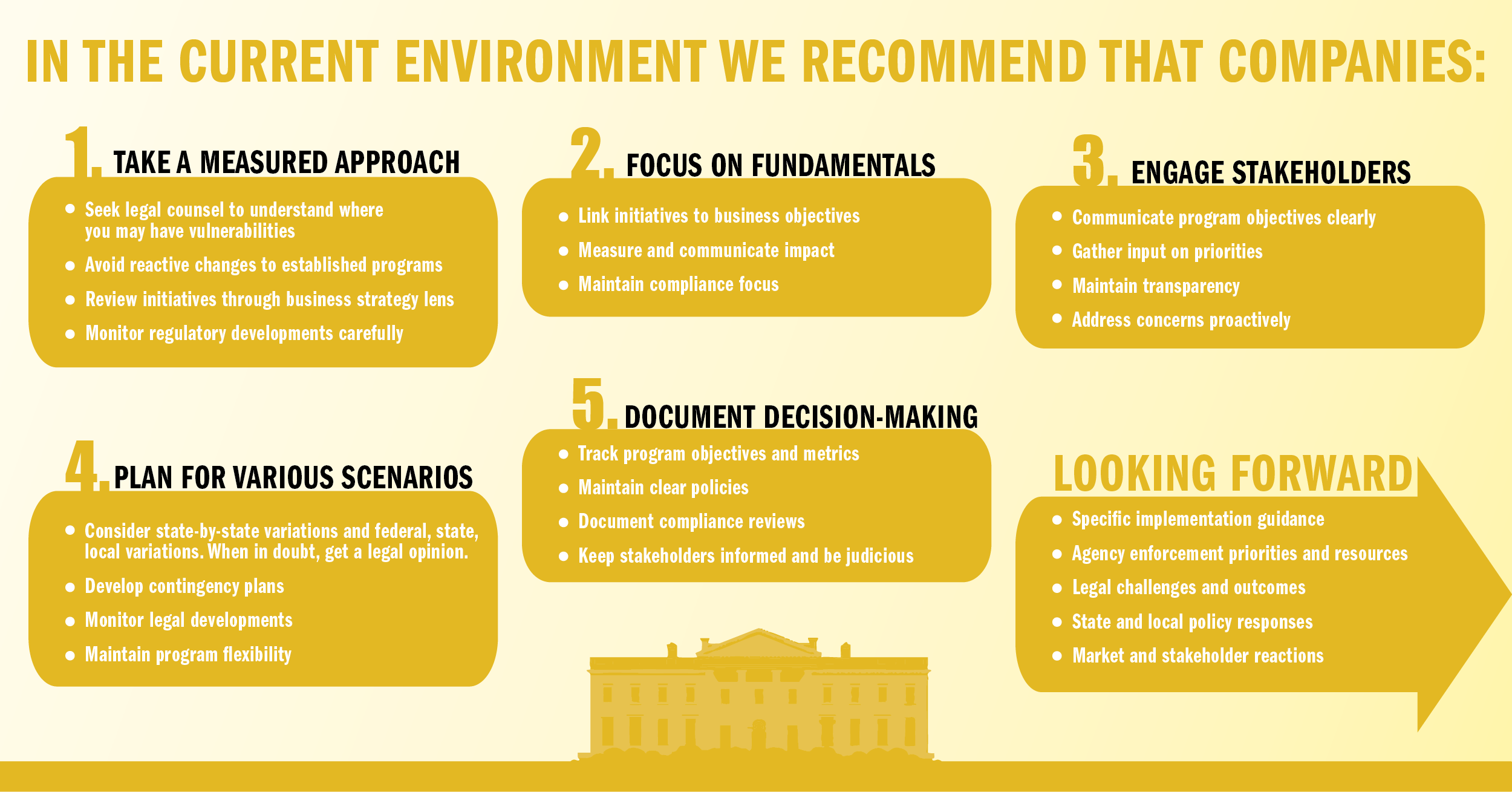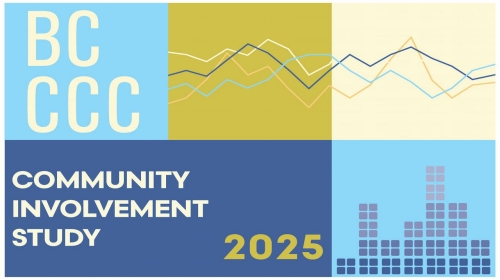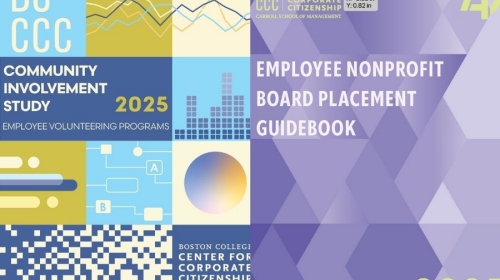WEBINAR: This webinar explores how corporate giving will be reshaped by the One Big Beautiful Bill. Hear directly from corporate citizenship leaders as they share innovative, real-world strategies that deliver impact for communities and results for business.
Early Impact Assessment of Executive Orders on Corporate Citizenship Initiatives: Part One

The first days of the Trump administration have yielded a plethora of executive orders and they are still coming. Executive orders are limited in scope and primarily affect federal agencies and contractors directly. However, they can signal policy priorities and influence broader corporate behavior through indirect effects on regulations, enforcement priorities, and market conditions. Many of these orders are predicted to be subject to litigation and some cases have been filed already. An excellent summary of actions reported by AP reporter, Bill Barrow, can be found here.
As of the date of this post, the orders haven’t made their way to the Federal Register but the texts can be found at https://www.whitehouse.gov/presidential-actions/.
Effects on DEI programs
For the orders signed on January 21-23, 2025 the signals about where companies might expect action are made explicit in the order titled ENDING ILLEGAL DISCRIMINATION AND RESTORING MERIT-BASED OPPORTUNITY. This order revokes many earlier executive orders to advance anti-discrimination measures within federal agencies and the contractors from which they procure goods and services. In addition to the prohibitions outlined, the order also advises the following to deter DEI programs and principles:
“…as a part of this plan, each agency shall identify up to nine potential civil compliance investigations of publicly traded corporations, large non-profit corporations or associations, foundations with assets of 500 million dollars or more, State and local bar and medical associations, and institutions of higher education with endowments over 1 billion dollars.”
No organization will want to be one of the nine identified per agency and thus, the work around diversity is likely to move more slowly and deliberately as the landscape unfolds. Additional orders define allowable gender identities (male and female) and eliminate all DEI and environmental justice roles, plans, and programs in federal agencies and offices. Some companies have anticipated this action and withdrawn their commitments to DEI. Others have maintained a focus on representation and equitable opportunity as a business issue, citing the shifting demographics of the U.S. consumer population and workforce to an increasingly diverse racial and ethnic composition as the business rationale for maintaining their efforts to align their strategies to meet the expectations of our increasingly more diverse younger generations.
Effects on climate and environmental measures
As expected, the U.S. has withdrawn from the Paris Climate Agreement. The order withdraws funding from the International Climate Finance Plan. Michael Bloomberg has stepped in (as he did under the previous Trump administration) to provide financial support to stop-gap this shortfall. Other orders remove barriers to drilling on both private and public land and create barriers to electric vehicle (EV) infrastructure and wind energy leases, attempt to override wildlife protection measures in California and Alaska. These environmental protection Initiatives are deemed likely to be litigated as well. Regardless, many sustainability drivers remain strong, such as:
- Consumer demand for environmental responsibility
- Investor focus on climate and transition risk
- Supply chain resilience requirements
- State and local regulations
- International expectations
There will continue to be tension around corporate sustainability (ESG) reporting. It is clear that there will be no new climate or human capital rules coming from the SEC in the near term. While the European Union (EU) Omnibus legislative response to the CSRD simplification is not due until the end of February, Ursula von der Leyen’s remarks on November 8, 2024 indicated that the omnibus package would remove duplication in sustainability reporting and reconsider the number of data points required and also signaled that the commission was not targeting changes at the substance of the reporting. Most pundits predict a slower rollout for small and medium organizations with large organizations expected to be subject to reporting requirements as planned.

The EU’s Corporate Sustainability Reporting Directive (CSRD) represents the most comprehensive approach. It requires detailed reporting on environmental, social, and governance matters from a broad range of companies operating in the EU. This will affect thousands of US companies. The CSRD builds on existing frameworks while adding requirements for:
Double materiality assessments
Companies must report both how sustainability issues affect their business and how their business impacts sustainability. This represents a significant expansion beyond traditional financial materiality.
Standardized metrics
The European Sustainability Reporting Standards (ESRS) provide detailed, mandatory indicators across environmental and social dimensions. This standardization aims to improve comparability and reduce selective disclosure.
External assurance
Third-party verification of sustainability reports becomes mandatory, elevating these disclosures closer to financial reporting standards.
California's Climate Corporate Data Accountability Act (SB 219) takes a more focused approach centered specifically on greenhouse gas emissions. While narrower in scope than the CSRD, it still creates significant new requirements:
Scope 3 emissions
Companies must report not just their direct emissions but also those from their value chain. This creates complex measurement and verification challenges.
Lower thresholds
The $1 billion revenue threshold captures many companies not subject to the CSRD, including private companies.
State-level enforcement
Unlike federal regulations, enforcement comes through California state mechanisms, creating potential jurisdictional complexity.
The following earlier executive orders are revoked and any offices established therein are abolished:
(i) Executive Order 13990 of January 20, 2021 (Protecting Public Health and the Environment and Restoring Science to Tackle the Climate Crisis);
(ii) Executive Order 13992 of January 20, 2021 (Revocation of Certain Executive Orders Concerning Federal Regulation);
(iii) Executive Order 14008 of January 27, 2021 (Tackling the Climate Crisis at Home and Abroad);
(iv) Executive Order 14007 of January 27, 2021 (President’s Council of Advisors on Science and Technology);
(v) Executive Order 14013 of February 4, 2021 (Rebuilding and Enhancing Programs to Resettle Refugees and Planning for the Impact of Climate Change on Migration);
(vi) Executive Order 14027 of May 7, 2021 (Establishment of the Climate Change Support Office);
(vii) Executive Order 14030 of May 20, 2021 (Climate-Related Financial Risk);
(viii) Executive Order 14037 of August 5, 2021 (Strengthening American Leadership in Clean Cars and Trucks);
(ix) Executive Order 14057 of December 8, 2021 (Catalyzing Clean Energy Industries and Jobs Through Federal Sustainability);
(x) Executive Order 14072 of April 22, 2022 (Strengthening the Nation’s Forests, Communities, and Local Economies);
(xi) Executive Order 14082 of September 12, 2022 (Implementation of the Energy and Infrastructure Provisions of the Inflation Reduction Act of 2022); and
(xii) Executive Order 14096 of April 21, 2023 (Revitalizing Our Nation’s Commitment to Environmental Justice for All).
(b) All activities, programs, and operations associated with the American Climate Corps, including actions taken by any agency shall be terminated immediately.
Effects on corporate philanthropy
The group of actions summarized above will undoubtedly have impacts in communities of color and organizations serving vulnerable populations. Companies may be called upon by their communities to fill these gaps. The most direct impacts on corporate giving would likely come through changes to tax policy or regulatory enforcement rather than executive orders themselves. There are no orders as of the date of this post that would seem to impact the multiple factors that companies typically consider when make philanthropic decisions.
In the current environment, we recommend that companies:
Take a measured approach
- Seek legal counsel to understand where you may have vulnerabilities
- Avoid reactive changes to established programs
- Review initiatives through business strategy lens
- Monitor regulatory developments carefully
Focus on fundamentals
- Link initiatives to business objectives
- Measure and communicate impact
- Maintain compliance focus
Engage stakeholders
- Communicate program objectives clearly
- Gather input on priorities
- Maintain transparency
- Address concerns proactively
Plan for various scenarios
- Develop contingency plans
- Consider state-by-state variations and federal, state, local variations. When in doubt, get a legal opinion.
- Monitor legal developments
- Maintain program flexibility
Document decision-making
- Track program objectives and metrics
- Maintain clear policies
- Document compliance reviews
- Keep stakeholders informed and be judicious
 Looking Forward
Looking Forward
The full impact of executive orders will depend on:
Specific implementation guidance
Agency enforcement priorities and resources
Legal challenges and outcomes
State and local policy responses
Market and stakeholder reactions
Related Content
This study explores shifting trends in employee volunteering, corporate giving, and other means of corporate community involvement.
This guidebook offers insights on placing employees in nonprofit board service roles.
This Member Meetup focused on strategies for building compelling business cases for corporate social responsibility initiatives. Two organizations shared their approaches to securing leadership buy-in and funding for CSR programs by anchoring requests in business strategy, quantifying value, and crafting persuasive narratives.
RESEARCH BRIEF - To examine whether CSR Activities affect Long-term Stock Returns, researchers studied 6971 observations of common stock of Japanese firms operating globally, along with accounting data and ownership data.
RESEARCH BRIEF - The study utilized a dataset of 28 globally listed airlines with 420 firm-year observations of ESG data over time.
Check out the latest findings and best practices from BCCCC's Community Involvement Board, comprised of corporate leaders working in corporate giving, community relations, and related roles.
Check out the latest findings and best practices from BCCCC's ESG Reporting Board, comprised of corporate leaders working in sustainability reporting.







